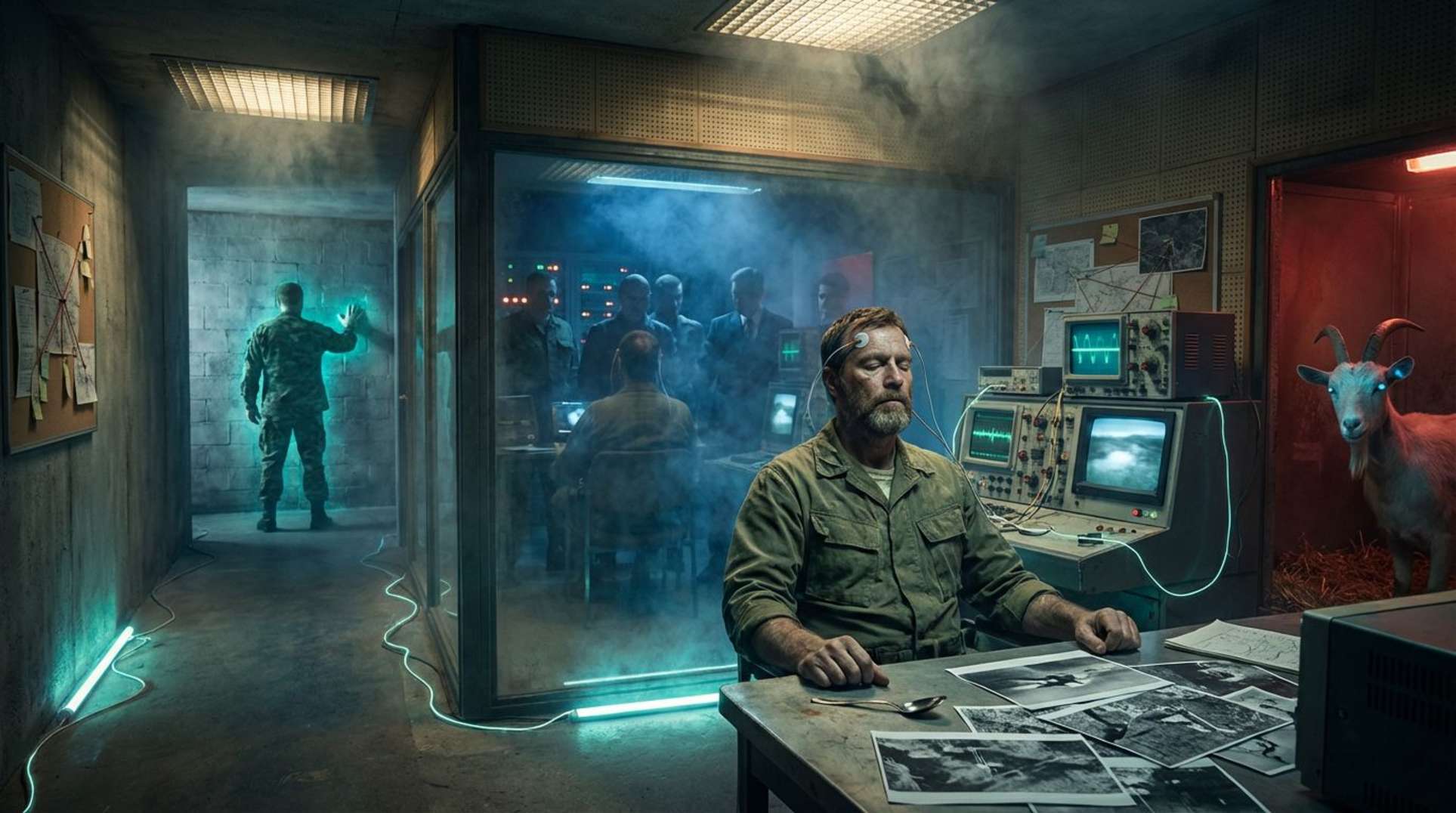You’ve heard the wild tales of America’s psychic soldiers, but the truth is a twisted mix of fact and fiction—yes, the U.S. military chased mind-over-matter warfare, yet the reality exposes a stranger, more grounded saga where flashy paranormal flops hid lasting shifts in elite training.
- Key Takeaway: Jim Channon, a Vietnam War lieutenant colonel, wrote the First Earth Battalion operations manual in 1979, proposing a New Age-inspired unit of “supersoldiers” focused on non-lethal warfare, ESP, and ethical principles.
- Key Takeaway: The U.S. Army ran Project Jedi at Fort Bragg and the U.S. government funded the separate Stargate Project (1970–1995), pouring about $20 million into remote viewing and psychic research in response to reported Soviet programs.
- Key Takeaway: Most spectacular psychic feats—walking through walls, stopping animals’ hearts by staring, reliable ESP in combat—never panned out, but some of the softer ideas about human potential and non-lethal tactics influenced later Special Forces training and doctrine.
The Hook: A war hero, a zero-casualty claim, and a manual for warrior monks
Picture this: A battle-hardened Vietnam vet, medals pinned to his chest, sits in a sterile Pentagon room. He’s not plotting airstrikes. No. He’s doodling mandalas and outlining a squad of “warrior monks” who hug daily, read minds, and resolve wars without firing a shot. This isn’t some hippie fever dream—it’s 1979, and Lieutenant Colonel Jim Channon is dead serious. Fresh from two brutal tours in Vietnam, where he boasts his unit escaped without a single casualty (a claim the brass never bothered to verify, or so the records suggest), Channon taps into the Human Potential Movement. Counterculture vibes crash into military grit. The post-Vietnam Army is reeling—confidence shattered, soldiers broken. What if warriors could evolve? Become enlightened guardians? But lurking in the shadows: whispers of Soviet mind weapons. Generals sweat. Could the enemy be harnessing the unseen? Channon’s hand-illustrated manual for the First Earth Battalion drops like a bomb. Hugging rituals. ESP drills. Non-lethal showdowns. And yes, top brass like Albert Stubblebine actually try walking through walls, convinced it’s the edge they need. Absurd? Sure. But in that era of doubt and dread, it felt like survival.
Why do people think America trained an army of psychic super-soldiers?
The legend spreads like wildfire online and in Hollywood flicks. Soldiers staring down goats until their hearts burst. Generals phasing through solid walls. CIA psychics lounging in U.S. bunkers, projecting their minds to spy on Soviet silos. Spoon-bending parties where officers twist metal with sheer will. It all paints this picture of a secret U.S. army of mind warriors, blending telepathy, out-of-body jaunts, and ethical mysticism into unbeatable supersoldiers. Channon’s First Earth Battalion manual fuels it, describing these non-lethal monks with godlike perception. Then there’s the blurred lines: Project Jedi’s Fort Bragg experiments, Stargate’s remote viewing ops—they morph into one massive “psychic warrior” conspiracy in the public eye. Intelligence folks hosting those cutlery-warping shindigs? Soldiers testing stares on animals? It’s the stuff of memes and midnight forums. And why not? Cold War paranoia made it believable—psychics breaching enemy lines without a trace, weaponizing thoughts amid nukes and spies. The myth thrives because it’s half-true weirdness, half-fantasy, perfectly tuned to question what the government hides.
The hard evidence: What the First Earth Battalion, Project Jedi, and Stargate actually did
The official narrative wants you to dismiss this as fringe nonsense, but dig into the declassified docs, and patterns emerge. These weren’t wild goose chases—they were structured programs with budgets, timelines, and evaluations. Let’s break it down.
Jim Channon and the First Earth Battalion
In 1979, Vietnam vet Jim Channon pens the First Earth Battalion manual, a wild blueprint for “warrior monks” blending New Age vibes with battlefield smarts. Inspired by the Human Potential Movement and his own combat scars, he pitches non-lethal tactics, ESP, and ethical codes. But here’s the catch: It never became a real unit. Just an unofficial think piece stirring Army debates.
Project Jedi at Fort Bragg
Distinct from CIA shadows, this Army Special Forces push at Fort Bragg toys with spoon-bending, sharpened senses, and psychic edges. Documentation is thin—mostly whispers and after-action notes—but it aimed to amp up soldiers’ mental game in a military wrapper.
The CIA’s Remote Viewers: Stargate
Starting in 1970 as SCANATE, funded by the CIA then shuffled to Army intel, Stargate runs until 1995. They train psychics for intel grabs on Soviet targets, logging thousands of sessions. Viewer Joseph McMoneagle claims 450 missions, like spotting a crashed Soviet plane. Total cost? $20 million. Reviews admit some stats tease anomalies, but nothing consistent or battle-ready. The CIA declassifies it in 1995, admitting it existed but flopped on proof.
| Program | Mythical Claim | What Actually Existed | Evidence Type |
|---|---|---|---|
| First Earth Battalion | Army unit of psychic warrior monks killing with thoughts and phasing through obstacles | Unofficial concept manual proposing non-lethal, ethical supersoldiers; no operational unit formed | Declassified documents and Channon’s manual vs. memoirs |
| Project Jedi | Elite soldiers mastering wall-walking, animal-killing stares, and combat ESP | Special Forces experiments in mental skills like perception and spoon-bending; limited scope | Sparse official reports vs. anecdotes and secondary accounts |
| Stargate | Reliable psychic spies disrupting enemies and gathering flawless intel remotely | 25-year program with remote viewing sessions for intelligence; inconsistent results | Declassified CIA/DIA reviews and summaries vs. participant memoirs |
The Cold War psychic race: Why serious people funded strange experiments
Don’t buy the line that this was all whimsy. The docs reveal a calculated hedge against Soviet shadows. U.S. intel buzzed with reports of Moscow dumping 60 million rubles yearly into “psychotronic” research around 1970. Researchers like H.E. Puthoff at SRI confirm: Stargate kicked off because the CIA feared the Reds were turning minds into weapons for espionage or psy-ops. The Federation of American Scientists backs it—America couldn’t risk a low-cost Soviet breakthrough in interrogations or hidden warfare. $20 million over 25 years? Pocket change next to nukes or jets. It let skeptics test without breaking the bank, probing if there was any edge in the unseen. From inside, it wasn’t sci-fi; it was smart paranoia, betting small to counter a potential game-wrecker. Why else would bureaucrats and brass keep it alive amid doubts?
The skeptic’s view: Ridiculous boondoggle or misunderstood innovation?
The official reports call it a bust—no reliable psychic intel from Stargate, leading to its 1995 shutdown. But connect the dots: Insiders like Edwin May, program director, admitted in his 1995 write-up that “the contemporary findings along with the output of the [Stargate] program do seem to indicate that something beyond odd statistical hiccups is taking place.” Anomalies lingered, splitting even the experts—noise or signal? Memoirs spice it with spoon-bending bashes and wall-walking flops, but those rest on shaky anecdotes, not ironclad proof. Skeptics rule: No goat-killing stares or mind weapons panned out. Yet, strip the woo, and real innovations hide. Mental drills, visualization, stress hacks—these echoed into modern Special Ops, emphasizing cognitive edge and non-lethal plays. The psychic dream flopped, but it pushed the military to redefine warriors as mind masters, not just muscle. Was it waste? Or a covert pivot toward ethical, brain-powered warfare that the brass won’t fully admit?
From warrior monks to modern operators: What actually survived from the psychic soldier dream?
Channon’s manual dreamed of hugging healers who protected without slaughter—non-lethal ethics, inner strength. The First Earth Battalion never deployed, but its echoes ripple. Special Forces doctrine absorbed non-lethal tools, psy-ops, and hearts-and-minds strategies, evolving from brute force. No direct handoff from Jedi or Stargate, but the vibe shifted: Mindfulness, resilience, awareness training now staples in elite units, minus the ESP hype. It was a sandbox for wild ideas, nudging the Army toward flexible, humane operators. Today’s warriors manage info wars and restraint—quiet legacies of that post-Vietnam rethink. The mind as weapon? It stuck, just not how they imagined.
Conclusion: How America’s strangest military experiment quietly rewrote the rules
Post-Vietnam scars and Soviet psychic scares birthed the First Earth Battalion blueprint, Project Jedi trials, and Stargate’s 25-year run—thousands of sessions, $20 million spent, all chasing mind miracles. Declassified files confess: No breakthroughs, just shutdowns in 1995. Channon sought humane supersoldiers through inner growth, but ESP fizzled. Still, the core idea endures—that battles hinge on minds, ethics, and unseen power. Forget the soldier glaring at a goat till it drops; picture the modern operator, mind sharpened like a blade, reshaping conflicts with subtlety the old guard never saw coming.




